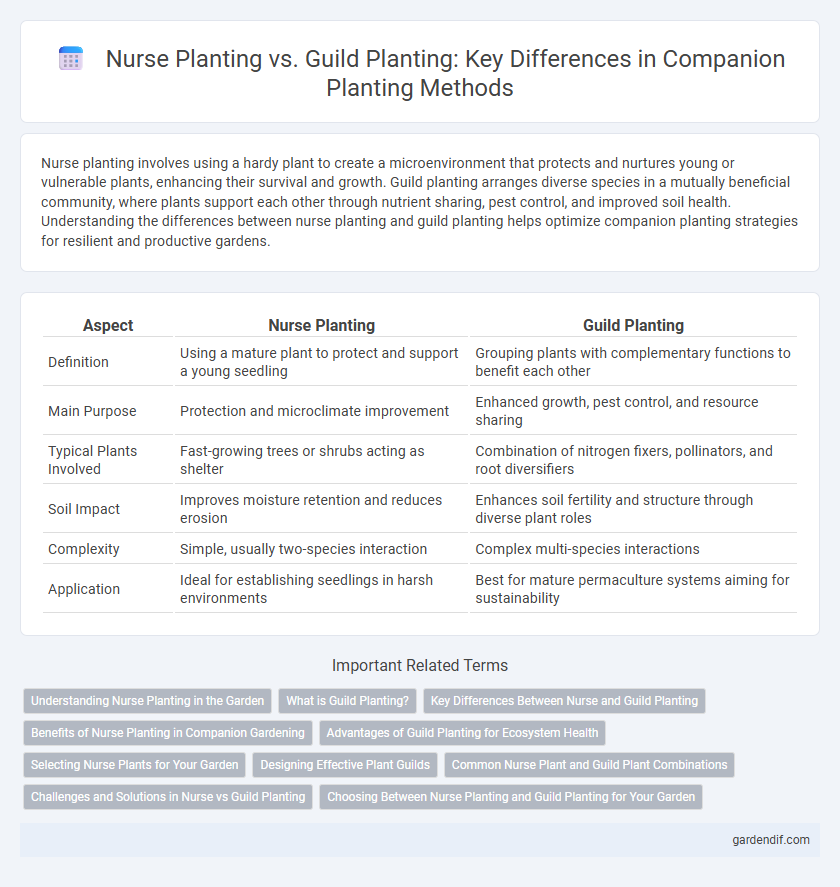
Nurse Planting vs Guild Planting Illustration
Nurse planting involves using a hardy plant to create a microenvironment that protects and nurtures young or vulnerable plants, enhancing their survival and growth. Guild planting arranges diverse species in a mutually beneficial community, where plants support each other through nutrient sharing, pest control, and improved soil health. Understanding the differences between nurse planting and guild planting helps optimize companion planting strategies for resilient and productive gardens.
Table of Comparison
| Aspect | Nurse Planting | Guild Planting |
|---|---|---|
| Definition | Using a mature plant to protect and support a young seedling | Grouping plants with complementary functions to benefit each other |
| Main Purpose | Protection and microclimate improvement | Enhanced growth, pest control, and resource sharing |
| Typical Plants Involved | Fast-growing trees or shrubs acting as shelter | Combination of nitrogen fixers, pollinators, and root diversifiers |
| Soil Impact | Improves moisture retention and reduces erosion | Enhances soil fertility and structure through diverse plant roles |
| Complexity | Simple, usually two-species interaction | Complex multi-species interactions |
| Application | Ideal for establishing seedlings in harsh environments | Best for mature permaculture systems aiming for sustainability |
Understanding Nurse Planting in the Garden
Nurse planting involves strategically placing hardy plants to create a protective microenvironment that supports the growth of more sensitive species by improving soil moisture, providing shade, and reducing wind stress. Unlike guild planting, which arranges diverse plants to promote mutual benefits through complex interactions, nurse planting focuses primarily on fostering early-stage growth and survival of target plants. This technique enhances garden resilience by mimicking natural succession and accelerating establishment of desired vegetation.
What is Guild Planting?
Guild planting is an ecological gardening method that arranges diverse plant species in a synergistic community to support each other's growth, improve soil fertility, and enhance pest resistance. It mimics natural ecosystems by combining nitrogen-fixing plants, ground covers, pollinator attractors, and nutrient accumulators within a single planting area. This approach goes beyond simple nurse planting by creating a complex, sustainable environment that maximizes productivity and biodiversity.
Key Differences Between Nurse and Guild Planting
Nurse planting involves using a single, hardy plant to provide shelter and improve growing conditions for a target plant, promoting survival in harsh environments. Guild planting consists of diverse, carefully selected plant species that support each other through nutrient cycling, pest control, and mutual growth benefits. The key difference lies in nurse planting's focus on individual plant protection, while guild planting emphasizes complex interspecies relationships within a productive ecosystem.
Benefits of Nurse Planting in Companion Gardening
Nurse planting in companion gardening fosters microclimates that protect young seedlings from harsh environmental stresses, promoting faster growth and higher survival rates. This method reduces water evaporation and soil erosion by using nurse plants to shield companion crops, enhancing overall garden resilience. Utilizing nurse plants boosts biodiversity, supports beneficial insect habitats, and improves soil health through natural nutrient cycling.
Advantages of Guild Planting for Ecosystem Health
Guild planting enhances ecosystem health by promoting biodiversity through the strategic combination of complementary plants that support nutrient cycling, pest control, and soil fertility. This approach creates a resilient micro-environment where plants mutually benefit from shared resources, reducing the need for chemical inputs and minimizing soil erosion. By mimicking natural ecosystems, guild planting fosters a balanced habitat that supports pollinators, beneficial insects, and microbial activity, ultimately improving overall ecosystem stability.
Selecting Nurse Plants for Your Garden
Selecting nurse plants for your garden requires considering species that provide optimal shade, moisture retention, and soil enrichment to support young or sensitive plants. Hardy, drought-tolerant plants like legumes and certain shrubs improve soil nitrogen and shelter seedlings from harsh sunlight, promoting healthy growth. Choosing nurse plants compatible with the primary crops enhances guild planting benefits by fostering a balanced micro-ecosystem and reducing maintenance needs.
Designing Effective Plant Guilds
Designing effective plant guilds involves selecting nurse plants that provide essential support such as shade, moisture retention, and pest deterrence to surrounding species, creating a microenvironment conducive to growth. Guild planting optimizes interspecies relationships by combining nitrogen-fixing plants, dynamic accumulators, and pollinator attractors to enhance soil fertility and biodiversity. Prioritizing plant compatibility, spatial arrangement, and seasonal succession ensures a resilient, self-sustaining plant community that maximizes productivity and ecological balance.
Common Nurse Plant and Guild Plant Combinations
Common nurse plants such as mesquite or acacia create microenvironments that protect young seedlings from harsh sunlight and moisture loss, promoting healthier growth. Guild planting involves grouping complementary species like nitrogen-fixing legumes with fruit trees, enhancing soil fertility and pest resistance for sustainable garden ecosystems. Typical guild plant combinations include oak trees with clover, comfrey, and herbs, maximizing nutrient cycling and biodiversity benefits.
Challenges and Solutions in Nurse vs Guild Planting
Nurse planting faces challenges such as limited species diversity and slower ecosystem development, while guild planting encounters complexity in managing multiple plant interactions and competition. Solutions for nurse planting include selecting resilient nurse species that improve microclimate and soil conditions, facilitating succession. In guild planting, careful design and monitoring ensure complementary functions, resource sharing, and reduced interspecies competition to optimize plant community health.
Choosing Between Nurse Planting and Guild Planting for Your Garden
Choosing between nurse planting and guild planting depends on your garden's specific needs and objectives. Nurse planting involves using certain plants to protect and nurture young plants by providing shade, moisture retention, or pest control, ideal for harsh environments or vulnerable species. Guild planting integrates diverse species in a synergistic community, enhancing soil fertility, pest resistance, and overall ecosystem health for more complex, mature garden systems.
Nurse Planting vs Guild Planting Infographic

 gardendif.com
gardendif.com